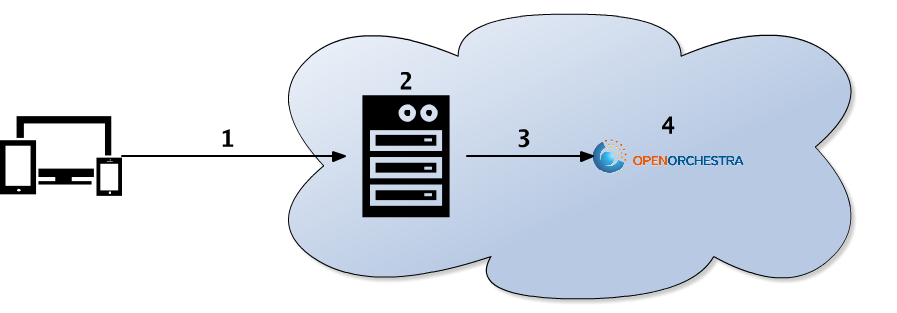Multi-device¶
Open Orchestra is compatible with the adaptive way of rendering web pages. The idea is to serve different html versions of the same document according to the device displaying it. For instance an iphone version could show less blocks than a computer version.
This diagram shows the main steps of the process:

- The client makes a request to the server to get a page. Regardless of the type of client (computer, mobile or tablet), the request is the same.
- The server catches the request and tag it with the client type
- The modified request is transmitted to Open Orchestra
- Open Orchestra processes the request and generates the final html. To render the page, the template engine selects automatically the correct template version according to the previously set header.
Prerequisite¶
To enable the multi-device rendering, the server entry point (webserver or reverse-proxy) must be able to detect the client device type and to add a request header corresponding to that device type. A good way to do that is to use a tool implementing the Wurfl library. Varnish for instance can do that task. The device detection must also be set up.
Configuration¶
To activate the adaptive response, all the devices name requiring a specific template have to be defined in the configuration:
#app\config\config.yml
open_orchestra_front:
devices:
web: ~
tablet:
parent: web
phone:
parent: web
android:
parent: phone
If we take a closer look at this configuration, we can see that four device types are declared : web, tablet, phone and androïd. We can also see that a fallback tree is generated:
- The web device is the default one
- Tablet and Phone device have the same parent: web. This generates a fallback from tablet templates to web templates and from phone templates to web templates. If a tablet template is required but can’t be found, the parent template version, ie web one on this example, will be used.
- On an androïd device, the parent is phone, introducing a new fallback.
Fallback mechanism is recursive, so if the parent alternative is not found, the grand-parent will be required, and so on until the default one. So default templates always have to be implemented.
Device detection¶
As seen on he prerequisite, the server entry point (webserver or reverse-proxy) must implement the
Wurfl library. This library tests the User-Agent and normalizes device names. With that information,
the server can patch the request headers by adding a parameter x-ua-device.
With the previous configuration sample, the generated header x-ua-device needs to be equal to
‘tablet’, ‘phone’ or ‘android’.
Open Orchestra does not provides configuration allowing that detection and headers modification, it’s up to you to configure the tool you’re using.
Template engine¶
When a template must be rendered, the method render of the template engine is called. So to
exploit the multi-devices features, the template engine must be updated with some functionalities.
Out of the box, Open Orchestra enhances the twig engine. If you need to use another template engine, you have to implement this logic on this engine.
Twig example¶
Here is how Open Orchestra enhances TwigEngine.
First both TwigEngine and TimedTwigEngine classes are extended in the FrontBundle:
FrontBundle\Twig\OrchestraTimedTwigEngine
FrontBundle\Twig\OrchestraTwigEngine
The FrontBundle\Twig\Renderable trait overrides the render() method by adding the device
name in the template name, exploring the previously set request header x-ua-device.
if (strstr($name, 'twig')) {
return str_replace('html.twig', $device . '.html.twig', $name);
}
The newly extended template engine can now be declared in the conf:
#FrontBundle\Resources\config\twig.yml
parameters:
open_orchestra_front.twig.orchestra_twig_engine.class: OpenOrchestra\FrontBundle\Twig\OrchestraTwigEngine
services:
open_orchestra_front.twig.orchestra_twig_engine:
class: \%open_orchestra_front.twig.orchestra_twig_engine.class\%
arguments:
- \@twig
- \@templating.name_parser
- \@templating.locator
- \@request_stack
- \%open_orchestra_front.devices\%
alias: templating
Required templates¶
Once the template engine is able to get the correct template alternative according to the request header, the matching templates have to be created. In our example, each template have to be declined as follow :
- default template version : myTemplate.html.twig
- tablet template version : myTemplate.tablet.html.twig
- phone template version : template.phone.html.twig
Note that if an alternative version is not created, the fallback mechanism will check for the parent alternative. So again, each alternative are optionals, but the default template is required to prevent the fallback mechanism to crash.